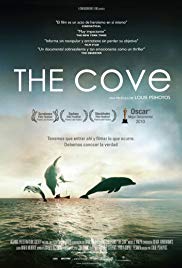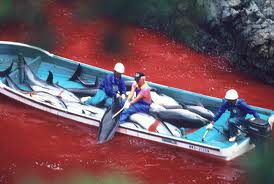1. Are dolphins who are captured and then put into dolphinariums and required to perform for human audiences “enslaved?”
Suggested Response:
Reasonable minds will differ on this question. Richard O’Barry, one of the foremost dolphin trainers in the world, would say that they are. He contends that dolphins are intelligent beings who know the difference between life in the open sea and life in captivity and who grieve their losses. Dolphins experience sensory deprivation in captivity not unlike people who are placed in solitary confinement. Since dolphins in dolphinariums are required to perform in order to eat, they are being required to perform forced labor. That’s just like slavery. The definition of slavery is usually reserved for human beings but is there any reason not to extend it to highly intelligent beings such as dolphins? [TWM agrees that dolphins in dolphinariums are enslaved and has adopted that nomenclature in this Learning Guide.] On the other hand, dolphins are not people, but do homo sapiens have the right to exploit other species at will? A good discussion of this question will include these concepts.
Here is another related question that can lead to great discussions: Do these considerations apply to dolphins who are born in captivity? If the enslavement of dolphins is banned, what should be done with them?
[For more questions about the ethics of zoos and marine mammal exhibition parks, see Learning Guide to Blackfish.]
2. Do you think that the Japanese people have the right as a society to continue the Taiji dolphin enslavement and slaughter? Joji Morishita, the Japanese delegate to the IWC featured in the movie, claims that efforts to restrict the Japanese whaling industry are “cultural imperialism.” The same argument can be made against objections by non-Canadians to the annual slaughter of harp seals, by non-Spaniards to bullfights, or by non-U.S. citizens to, let’s say, hunting deer for pleasure. Do these objections infringe upon the culture of Japan, Canada, Spain, and the U.S.?
Suggested Response:
Again, there is no one correct answer. A good discussion will include, at least, the following points. Some might challenge the concept of cultural sovereignty and point out that to the animals, and to the environment as a whole, human culture and the boundaries of nations mean nothing. Others may argue that cultural tradition is no excuse for cruelty — what about cultures that forbid equal rights for women? — and that people, because of our position of superiority over other animals, have responsibilities not to inflict pain and death upon them. On the other hand, what right do we have to believe that the solutions that our culture has developed to meet the challenges of existence are more ethical than the solutions developed by any other culture?
3. Audiences who see The Cove are routinely outraged. However, are we being hypocrites? Here are some facts that a defender of the dolphin slaughter might use to challenge critics.
- The entire Japanese dolphin slaughter kills or captures about 20,000 animals a year; a couple of thousand are taken at Taiji.
- In almost every developed country, millions of animals are killed for meat each year. For example, when the number of cows and pigs killed in the U.S. is described in terms of the number of animals slaughtered per second, the statics show that for every second of every day of the year, the U.S. meat industry slaughters one cow (actually it’s 1.1 cows) and 3.5 pigs. If a minute is spent reading this bullet point, that’s 66 cows and 210 pigs — all killed. While Japan takes 20,000 dolphins a year; the U.S. slaughters well over 20,000 cows every 6 hours.
- Like dolphins, cows and pigs are sentient beings who love their offspring, hate pain, and want to continue living. Reports from slaughterhouses routinely show that as animals are forced towards the killing floor, many express their terror.
- While they may not be as smart as dolphins, cows are smart enough to know what they want: don’t ever try getting between a cow and its calf. Pigs are highly intelligent, smarter than dogs, and very sensitive to emotions.
- Moreover, cows and pigs killed by the U.S. meat industry usually spend large portions of their lives standing in excrement in feed lots or confined to small cages on concrete floors. The dolphins captured or killed at Taiji swim free in the ocean all their lives except for a day or two of terror at the cove.
- The meat industry in every nation exists only because consumers like the taste and texture of flesh. People don’t need to eat meat to have a healthy diet. In fact, human beings thrive on a plant-based diet. Therefore, it’s not just the meat industry itself which is responsible for the massive killing of animals in developed countries, it is the consumers of meat who are ultimately responsible.
The question again, a little more precisely: Isn’t any person who eats meat being hypocritical when he or she criticizes the Taiji dolphin enslavement and slaughter?
Click here for an illustration of the question which can be reproduced and handed out or shown on a screen.
Suggested Response:
Obviously, the defender of what happens at Taiji cove has a point, but many will contend that cows and pigs are much less intelligent than dolphins. This discussion can lead to many other excellent discussion questions. For example, does the fact that dolphins may be more intelligent than farm animals make their pain, suffering, or death significantly worse than the pain, suffering, and death of cows and pigs? What about dogs and cats? [The movie Charlotte’s Web explores this idea in a gentle fictional context.] What about other primates such as chimpanzees, bonobos, and gorillas? Also, is the act of inflicting pain on a dolphin or killing it unethical while the act of hurting and killing a less intelligent farm animal has no ethical implications? Again, what about the ethics of hurting and killing dogs and cats who, after all, are less intelligent than dolphins? Extend this question to primates who can be taught sign language and are, arguably, more intelligent than dolphins. (Note that there is an international movement to pass legislation giving basic rights the chimpanzees and gorillas, see Support the Great Ape Preservation Act from the Jane Goodall Institute.) These are all arguably propositions, great discussion prompts, and excellent research issues.
In the discussion, teachers may want to point out that doctors have discovered that a plant-based diet is the best defense against the most deadly diseases that afflict people in Western countries including cancer, heart disease, and diabetes. (See TWM Learning Guides to Forks Over Knives and Super Size Me.) Plant-based diets are also much better for the environment, using fewer resources to feed more people, than a diet that includes meat. These considerations lead to the question: If a plant-based diet is better for health and for the environment, then the only reason for continuing to eat meat is that people like the taste and texture of flesh. If the purpose of ethics is to reduce suffering and increase pleasure for the largest number sentient beings (a principal of Utilitarian philosophy when the circle of compassion is extended to sentient animals), then is mankind’s desire for the taste of meat, a relatively trivial interest, sufficient justification for causing other animals pain and a brutal early death? Some students will say that what happens to animals doesn’t matter; others will take the opposite position. Teachers who take the discussion to this level should note that their class has just engaged in a college-level discussion of philosophy and ethics.
The statistics for the U.S. meat industry cited in the question are for the year 2011 from the USDA publication entitled, “Livestock Slaughter 2011 Summary, April 2012” Assuming 31,536,000 seconds in a year; annual slaughter statistics are, rounding to the nearest thousand, cattle (including calves) 34,938,000 or 1.1 per second and hogs 10,260,000 or 3.5 per second.
4. Are human societies most likely to defend animals when there is no cost? Look at Spain which maintains a barbaric tradition, the bullfight, but which was the first country to adopt the Great Ape Protection Act.
Suggested Response:
There is no one correct answer.



